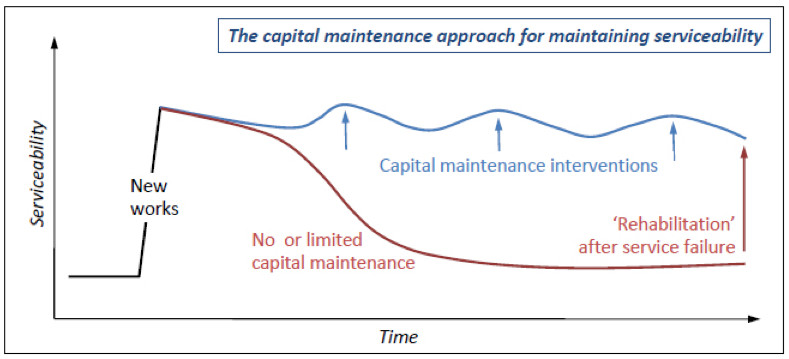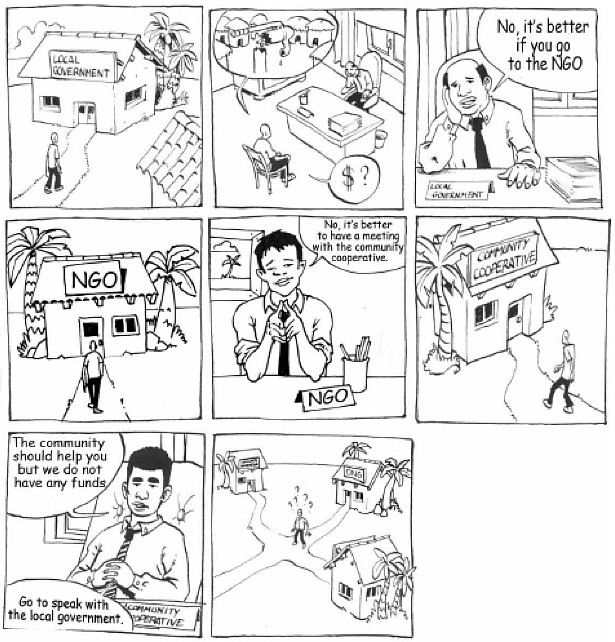Capital Maintenance Expenditure (CapManEx)
Capital maintenance expenditure is the costs of renewing, replacing, rehabilitating, refurbishing or restoring assets to ensure that services continue at the same level of performance that was first delivered. Examples include replacing a motor on a power pump or the pump rods/rising main/handle in a handpump; cleaning/re-excavating the base of a hand-dug well; relaying the drainage field for a septic tank; flushing a borehole which no longer delivers the desired flow; cleaning a water tank, etc. The renewal of these assets, often after some years of operation, ensures the same level of service that users received when the asset was first installed.
Planning for capital maintenance expenditure is crucial to the sustainability of water, sanitation and hygiene services as shown in figure 1. The red line shows a steady decline in service levels in the absence of capital maintenance as a system degrades over time. Eventually there is a need for renewed capital expenditure to replace the asset. The blue line shows service levels being maintained as the asset is maintained.
Figure 1. Capital maintenance expenditure
Difference between operational expenditure and capital maintenance
When an existing system undergoes minor maintenance, for example regular greasing of bearing points or tightening of pump bolts, the related cost is part of operational and minor maintenance expenditure (OpEx). The point where minor maintenance becomes capital maintenance is a matter of frequency; does the cost occur more than once a year? and of amount; Is the cost significant compared to the on-going operational expenditure? For example, although the cost of emptying a twin pit or shallow pit-latrine may be significant compared to the initial investment needed for construction, it occurs frequently, at least compared to the life cycle of the latrine itself, and does not constitute a physical renewal. Thus, it is considered as operational and minor maintenance expenditure (OpEx). However, the cost of emptying a single deep pit might only be needed once every five to ten years and might usefully be considered as capital maintenance expenditure. The replacement of a small valve on a piped system, or repairing a leaking pipe is operational and minor maintenance expenditure (OpEx), although its failure can significantly affect the serviceability of the system, because this is a small cost which occurs frequently compared to the life of the system. Replacing a length of pipe because there have been a number of leaks, or replacing a major valve after several years of use would be classified as capital maintenance expenditure.
Examples
Video capital maintenance expenditure
In this video interview of 6.47 minutes, Life-cycle costs with Erik Stowe, from the non-governmental organisation Splash (formerly known as A Child's Right) talks about how capital maintenance expenditure is often forgotten and also how he has tried to explain capital maintenance expenditure to their international staff.
Benchmarks capital maintenance
Based on research from the WASHCost project, the minimum capital maintenance expenditure to provide a basic level of water service with a borehole and handpump (at 2011 prices) ranges from US$ 1.5 per person to just over US$ 2 per person (see table 1). For all piped schemes, including mechanised boreholes and piped supplies, the costs range from US$ 1.5 to just over US$ 7 per person.
Table 1. Cost ranges for capital maintenance expenditure [min-max] in US$ 2011 per person, per year
| Borehole and handpump | 1.5 -2 |
| All piped schemes | 1.5 -7 |
Source: IRC, 2012
The costs as shown in table 1 (above) are based on the provision of a basic level of water service, as defined by WASHCost. A basic service implies that the following criteria have been realised by the majority of the population in the service area: People access a minimum of 20 litres per person per day, of acceptable quality (judged by user perception and country standards) from an improved source which functions at least 350 days a year without a serious breakdown, spending no more than 30 minutes per day per round trip (including waiting time).
Based on research from the WASHCost project, the minimum capital maintenance expenditure required to provide a basic level of sanitation service ranges from US$ 0.5 to just over US$ 1.5 per person, for a Traditional Pit latrine, between US$ 1 – 3 for a Ventilated Improved Pit (VIP) latrine and between US$ 2 – 6 (2011 prices) for pour Flush or septic tank latrines (see table 2).
Table 2. Cost ranges for expenditure on capital maintenance expenditure [min-max] in US$ 2011 per person, per year
| Traditional Pit latrine with an impermeable slab (often made from local materials) | 0.5 – 1.5 |
| Ventilated Improved Pit latrine | 1 - 3 |
| Pour Flush or septic tank latrines | 2 - 6 |
Source: IRC, 2012
The costs as shown in table 2 (above) are based on the provision of a basic level of sanitation service, as defined by WASHCost. A basic sanitation service implies that all the following criteria have been realised by the majority of the population in the service area: At least some members of the household use a latrine with an impermeable slab at the house, in the compound or shared with neighbours. The latrine is clean even if it may require high user effort for pit emptying and other long term maintenance. The disposal of sludge is safe and the use of the latrine does not result in problematic environmental impact.
When using these benchmarks (see table 1 and 2), local factors must be taken into account. For example, the lower cost ranges were generally, but not always found in India, while cost data from Latin America tends to be higher than the maximum ranges, but usually relates to higher service levels.
For both water and sanitation:
- If expenditure is lower than the minimum range, then there is higher risk of reduced service levels or long-term failure. A reduced service level means that one or more service criteria (e.g. access, quantity, use, quality and reliability) are not achieved. Service criteria can vary according to country context and norms.
- In the WASHCost research, use of latrines and reliability of services tend to be lower when recurrent expenditure on things such as operation and maintenance is low.
- If expenditure is higher than the maximum range, an affordability check (for both users and providers) might be required to ensure long-term sustainability.
- If a basic level of service is being delivered and expenditure is outside the cost benchmarks, then there may be context-specific explanations; such as the service is in a densely-populated area with economies of scale, or, conversely, the area is difficult or remote to reach.
Financing of capital maintenance
Mechanisms to finance long-term or capital maintenance have been less clearly defined and ongoing asset management is rarely planned for in programme implementation (Fonseca et.al, 2013). Tariffs, where used, are usually set at a level that should cover operational and minor maintenance but not the full replacement costs of assets. A fear that tariffs would be unaffordable to rural users has led to reluctance to introduce cost-reflective pricing in many low-income countries, much as in high-income countries.
Picture 1. Who is responsible for capital maintenance?
In practice, capital maintenance costs, which occur for instance when a pump needs to be replaced or a borehole redeveloped, are covered through a combination of any savings made by the community service provider and ad hoc funding by the service authority or an external project or programme. Unfortunately in many cases, these expenditures are simply not made, resulting in insufficient capital maintenance, which is reflected in high rates of nonfunctionality and poor service levels (Fonseca et.al, 2013).
Key documents
- Fonseca, C., Brikké, F. and Kouassi Komlan, E., 2005. Planning for Sustainable Cost Recovery in Community-Based Water Supply Services. Delft: IRC International Water and Sanitation Centre.
- Fonseca C., Smits S., Nyarko K., Naafs A. and Franceys R., 2013. Financing capital maintenance of rural water supply systems: current practices and future options. (Working Paper 9). The Hague, The Netherlands: IRC International Water and Sanitation Centre.
- This 40-page working paper provides case study evidence on current practices around funding capital maintenance, including the levels of funding provided and the resulting impact on services.
- Franceys, R. and Pezon, C., 2010. Services are forever: the importance of capital maintenance (CapManEx) in ensuring sustainable WASH services. (WASHCost briefing note; no. 1b). The Hague, The Netherlands: IRC International Water and Sanitation Centre.
- This 8-page briefing note introduces the concept of capital maintenance expenditure.
- IRC, 2012. Providing a basic level of water and sanitation services that last: cost benchmarks. (WASHCost infosheet; 1). The Hague, The Netherlands: IRC International Water and Sanitation Centre.
- Information sheet provides an overview of the minimum benchmarks for costing sustainable basic services in developing countries. The benchmarks have been derived from the WASHCost project dataset and the best available cost data from other organisations all over the world. The benchmarks are useful for planning, assessing sustainability from a cost perspective and for monitoring value for money.
Links
- WASHCost was five-year action research programme, running from 2008 to 2012. The WASHCost team gathered information related to the costs of providing water, sanitation, and hygiene services for an entire life cycle of a service -- from implementation all the way to post-construction. The WASHCost programme was led by IRC International Water and Sanitation Centre with several partners to collect data in the rural and peri-urban areas of Burkina Faso, Ghana, India, and Mozambique. For more information see: WASHCost
- The Costing Sustainable Services online course was developed to assist governments, NGOs, donors and individuals to plan and budget for sustainable and equitable WASH services, using a life cycle cost approach. The Life cycle cost approach is a methodology for costing sustainable water, sanitation and hygiene service delivery and comparing the costs to the level of service received by users. For more information see: washcost.info/page/2448
- Triple-S (Sustainable Services at Scale) is a six-year, multi-country learning initiative to improve water supply to the rural poor. It is led by IRC International Water and Sanitation Centre. The initiative is currently operating in Ghana and Uganda. Lessons learned from work in countries feeds up to the international level where Triple-S is promoting a re-appraisal of how development assistance to the rural water supply sector is designed and implemented. For more information see: Water Services That Last

